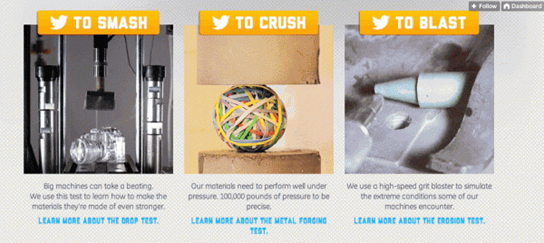How To Use Content Marketing To Attract Talent
How To Use Content Marketing To Attract Talent
Here’s a question for you: When you think about content marketing, who is it for?
If you answered for attracting customers, you’re right (mostly).
But, you see, that’s not always the case.
Turns out, content marketing isn’t just for reaching out to prospective customers.
In fact, lots of brands are using content marketing to attract future employees; highly skilled and creative team members who can jump in and help bring the brand to even higher levels.
Think about it, what are the main goals for content right now?
1.Increasing brand awareness
2.Creating customer trust
3.Building customer engagement
Doesn’t that sound like something a brand also does with its prospective employees?
Right now, with the global economy on the upswing, more and more digital jobs, and a workforce that is more demanding, the hiring process has become longer than ever.
A study done by Dice Holdings has found that time to fill a role now is running an average of approximately 27 working days, the highest level in fifteen years. This graph, from the same study highlights the uptick.

For industries like finance and health care, those numbers are even higher.
All of these issues can lead to a talent shortage. A Manpower study found that almost a third of employers are struggling to find top talent to fill roles they had in 2015.
It shouldn’t come as any surprise that a shortage in talent can have a highly negative trickle down effect inside a company on things like employee productivity, training costs, ability to serve clients and overall competitive advantage in the marketplace.
These are just some of the reasons why many companies are taking an altogether different approach to hiring now.
Instead of doing things the conventional way, human resources managers and recruiters are looking to mimic content marketing. They are creating high quality content that helps to position their brand, not to prospective customers, but to prospective employees.
So, now what are HR managers and recruiters supposed to do about this massive talent crunch, and high levels of competition? We’ve got a few ideas.
Identify Influencers
One way to start using content marketing to hire talent is to really understand your target. Just as a content marketer needs to know who their ideal target persona is, so should an HR manager.
To do this, it’s important to dig deep into who your ideal hire is: where do they hangout online, what social media account do they visit most often, what influencers do they absolutely adore?
You can not only identify and partner with influencers in your industry and feature them in your social media or on your blog, but your brand can also work to become the influencer in the industry as well (including many of your current employees).
One example is to look at Gary Vaynerchuk, the CEO and Co-Founder of VaynerMedia. When he started the brand with his brother they had twenty employees, now they have over 500.

One of the biggest reasons of that is because of Gary himself, he’s the ultimate social media influencer, which works great when you’ve built a brand that is a full service digital media agency.
Because Gary was all over the internet sharing his thoughts on social media, it was incredibly easy to recruit employees, they all wanted to work with “the guy” who was the guru of social.
Create Proven Content
Let’s face it, awesome content gets results. But with HR, the days of simply posting up an available job on a board and waiting will the applications roll in is coming to an end.
That’s why companies have to start getting creative and look again to content marketing. One of the best ways to get potential employees interested in your brand is to build content that is geared towards increasing both traffic and authority.
This means putting the brand out there by creating a number of different styles and types of content that can be seen across a number of channels.
Here are a just a few examples:
●Company blog
●Employee blog
●Company podcast
●Social media accounts
●Case studies
●Video testimonials
●Livestream events
Remember, the content that people love today is information that informs, educates, entertains, and engages.
Company blogs can serve as so much more than just a list of benefits and job openings, instead look to educate and delight the employees you are trying to attract. Use your content not only as a way to speak directly to people who are looking to get hired now, but as a way to stay on the radar of potential employees in your industry.
You never know, the perfect future employee could be one that absolutely loves your weekly newsletter but hasn’t decided to change jobs, yet.
GE Spring Break It
General Electric is a perfect example of this. They created a tumblr account around the theme #SpringBreakIt that showcased how they test advanced materials by smashing them. The site had everything from videos to infographics to gifs, all highly visual and engaging.
But here’s the really clever bit: the content was specifically geared not only towards customers, but also potential employees.

As the campaign wrapped up GE found colleges, industry audiences, and engineering firms also loved and shared the videos, putting the GE Advanced Materials Division on the map for a lot of young engineers (and future potential employees).
GE was able to create proven content that embraced the new digital age, stayed true to their brand message, but was able to have a viral attraction to their ideal target employees all at the same time.
Optimize Your Content
Content marketers focus on optimizing their content for conversions. They want ever blog post, Instagram ad, or Snapchat to move their potential customers to do something: click to read, click to call, buy, follow, etc.
Human resources managers and recruiters need to start doing the same thing with their content.
Here are a few scary stats from a CareerBuilder study:
●60% of job seekers have quit filling out an application because they feel it is too long and complex.
●About 45% of employers do not offer the option for applicants to apply using a mobile device, generally because of technical or resource constraints.
●When job-seekers cannot apply via a mobile device, 65% say they rarely return to their desktop to finish the application.

This goes to show that a lot of companies are not optimized for actual results when it comes to their content, including their job application process.
Be Responsive
One big way to step forward with this is to be sure your site is responsive, that means optimized for mobile users. Another survey from Glassdoor found that 90% (yup that’s not a typo) of job seekers search for jobs via their mobile devices.
If your company site is not optimized for those visitors, there is a pretty big chance that they are never going to return.
Pay Attention to SEO
Another thing to pay attention to with it comes to optimizing your site is through SEO. Be sure to use the proper names, headings, titles, links, metadata, and even keywords in your content to ensure it comes up high in the search engine rankings.
This is especially true for local SEO. You might find the search term “web design job in Boston” is a long tail keyword with hundreds of searches a month that your company could easily rank for with some targeted content.
Promote, Promote, Promote
Finally, think about how the best content marketers promote their content both on and offline. They don’t simply click “publish” on a blog post and then hope the masses just find their work and come flocking.
Though, that would be nice.
No, they take to a number of different channels and promote it all over the place. Many content marketers also take content, break it down, and create new content out of it that can be promoted again and again.
Here are just a few places where companies can promote their content:
●Social media ads
●Tumblr
●YouTube
●Vine
●Snapchat
●Blogs
●Guest Posts
●Newsletters
●Job boards
●Industry forums
●Industry meet-ups
We could go on, but you get the idea.
Any single piece of content created can be promoted a number of times. Don’t simply share once and forget it, set up a consistent schedule where new content is constantly being creating and shared across a number of different channels all year round.
This is a great case study about how Deloitte’s Netherlands branch needed a ton of new employees in a market where the vast majority of people weren’t looking. So, they decided to launch a huge targeted content marketing campaign, creating accounts on Facebook, Twitter, LinkedIn, and YouTube that spoke directly to their ideal target employees.
Deloitte NL was able to harness the power of content marketing in conjunction with their blog, social media accounts, and dynamic hiring website to hit their recruitment targets.
Wrap Up
Well, there you have it. Hopefully, you see how important a fresh content marketing approach to brand recruiting can make a huge impact on the success of finding happy, engaged, and talented employees.
The HR managers and recruiters that are currently embracing content marketing and using the approach of content marketers towards customers in their approach to finding employees, the results can be pretty impressive.
What is your brand doing to include content marketing in your employee recruitment? Where can you push the envelope a bit and really take things to the next level?
